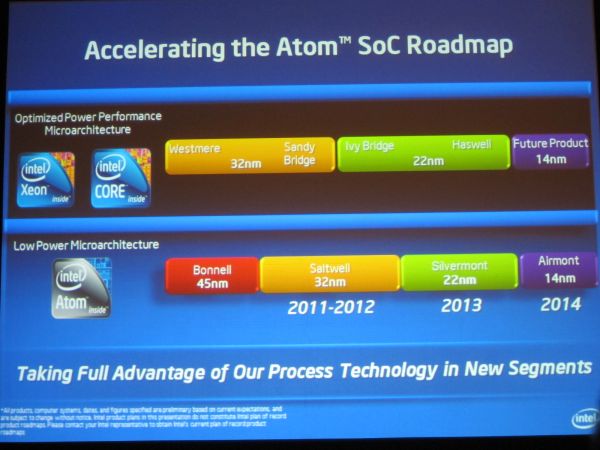Intel's Unified Design: Core & Atom Now Under One Roof
by Anand Lal Shimpi on September 13, 2011 3:26 PM EST- Posted in
- CPUs
- Intel
- Atom
- IDF 2011
- Trade Shows
Intel has had a bit of a reorg. The photo above depicts how Intel used to work. Core and Atom architecture development happened via independent design teams. Core was optimized for performance, Atom for low power. This is what Intel looks like now:
Core and Atom are developed under one unified design infrastructure. There are still independent design teams but there's going to be much more sharing of design, resources and execution. If there's a a particular IP block (e.g. integrated IO controller) that could be used in both Atom and Core architecture products it'll be easier to reuse across the entire family now. At a high level, Core will become more power efficient (really starting with Haswell) while Atom will leverage the performance learnings from the Core side. Everything becomes an SoC; it sort of has already.
Intel reaffirmed its commitment to a doubling of Moore's Law with regards to Atom. Each year from now through 2014 we'll see a new Atom part on a new process node. We'll get 32nm this year, 22nm next year and 14nm in 2014. The goal is to deploy Atom and Core architectures on the same process node with as little lag time between the releases as possible.


















7 Comments
View All Comments
davepermen - Tuesday, September 13, 2011 - link
all getting together..nice.
kjboughton - Tuesday, September 13, 2011 - link
lolzThis is not for the consumer, although Intel will certainly spin in it in this fashion. Two very different processor segments should NOT share the same foundation. This completely destroys the idea of design optimization based on performance vs. efficiency. Yes, there are some ideas to be shared, but it's not as if the teams don't collaborate now.
This is purely cost-cutting effort made in order to streamline Intel's R&D efforts in preparation for what is sure to be a next few years of rocky economic times.
There is nothing to cheer here.
Hector2 - Tuesday, September 13, 2011 - link
Let's all pretend that you know better than Intel on how to organize their tecnology developement. I'll give Intel credit for managing (and delivering) their technology roadmap pretty well.kjboughton - Tuesday, September 13, 2011 - link
Whoa there, Partner.No need to get your panties in a bunch.
I never claimed to know Intel's business better than they. Just making an observation based on my opinion of the matter.
I didn't see the sign asking that all dissenting opinions be withheld from comment. My bad.
Hector2 - Wednesday, September 14, 2011 - link
Then, of course, you don't mind me sharing my opinion either. My bad.jecs - Tuesday, September 13, 2011 - link
I think this has a lot to do with INTEL not wanting (or scare) from ARM to eat most of the mobile market, witch in the next few years appear to be, I don't know, 85% of the entire CPU market.Ultralight PCs, ultralight laptops, tablets, computer devices and or smartphones. Even desktops.
dealcorn - Friday, September 16, 2011 - link
Intel has aggressive goals for its graphics capabilities and it's sense is that Haswell provides the hardware support necessary to rapidly earn increased market share. It would be helpful to own the low cost credible gaming platform title currently held by AMD if it wants to insure that all game developers target the Intel architecture as their highest priority. Integration of the Haswell graphics core with the 22nm Atom CPU core (dual or perhaps quad) provides an architectural and cost framework that Intel can use to own the low cost credible gaming platform title while preserving Haswell's pricing structure. The above mentioned Unified Design strategy makes it easier to shuffle existing IP around so better products may be developed at reasonable cost.The Xeon version of Atom may be the biggest beneficiary of this change if it leads to a faster implementation of the vector processing unit that supports AVX2.